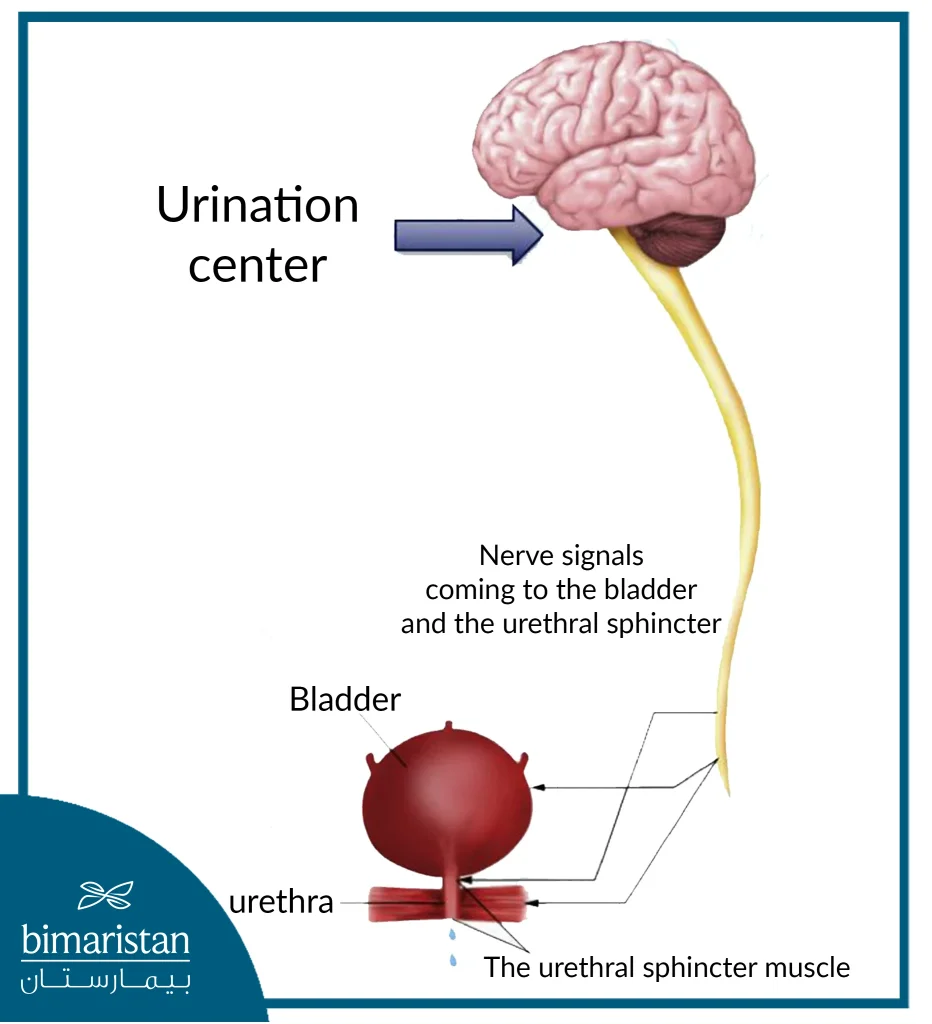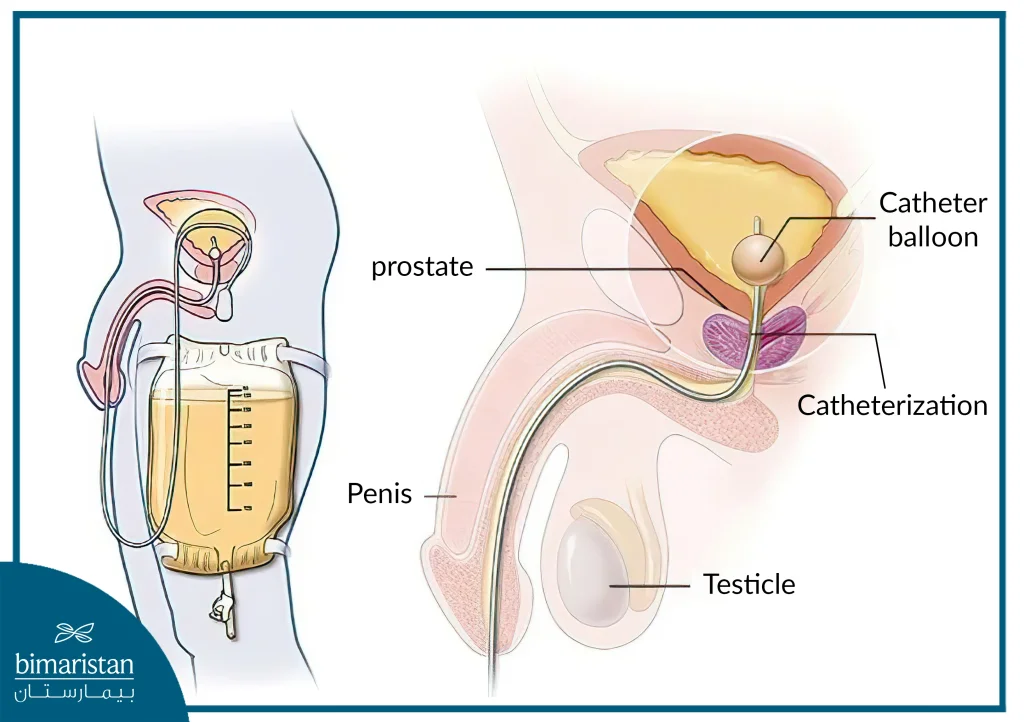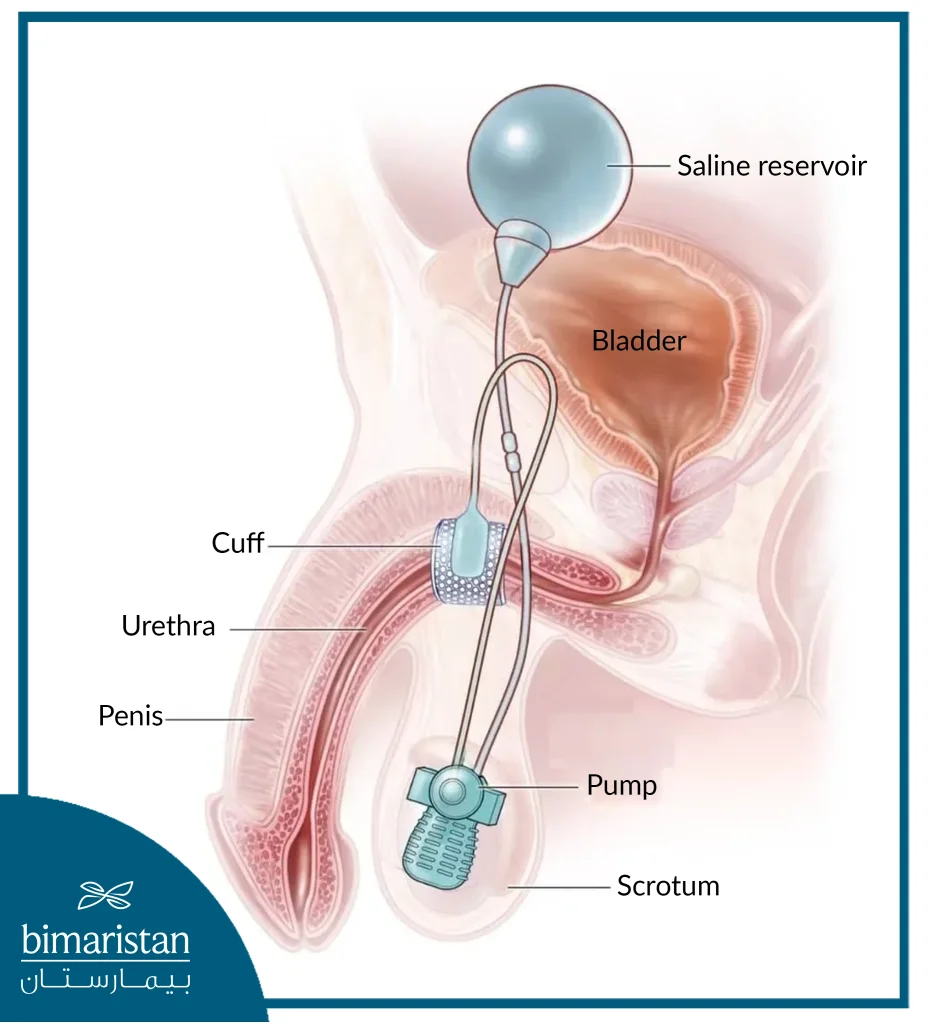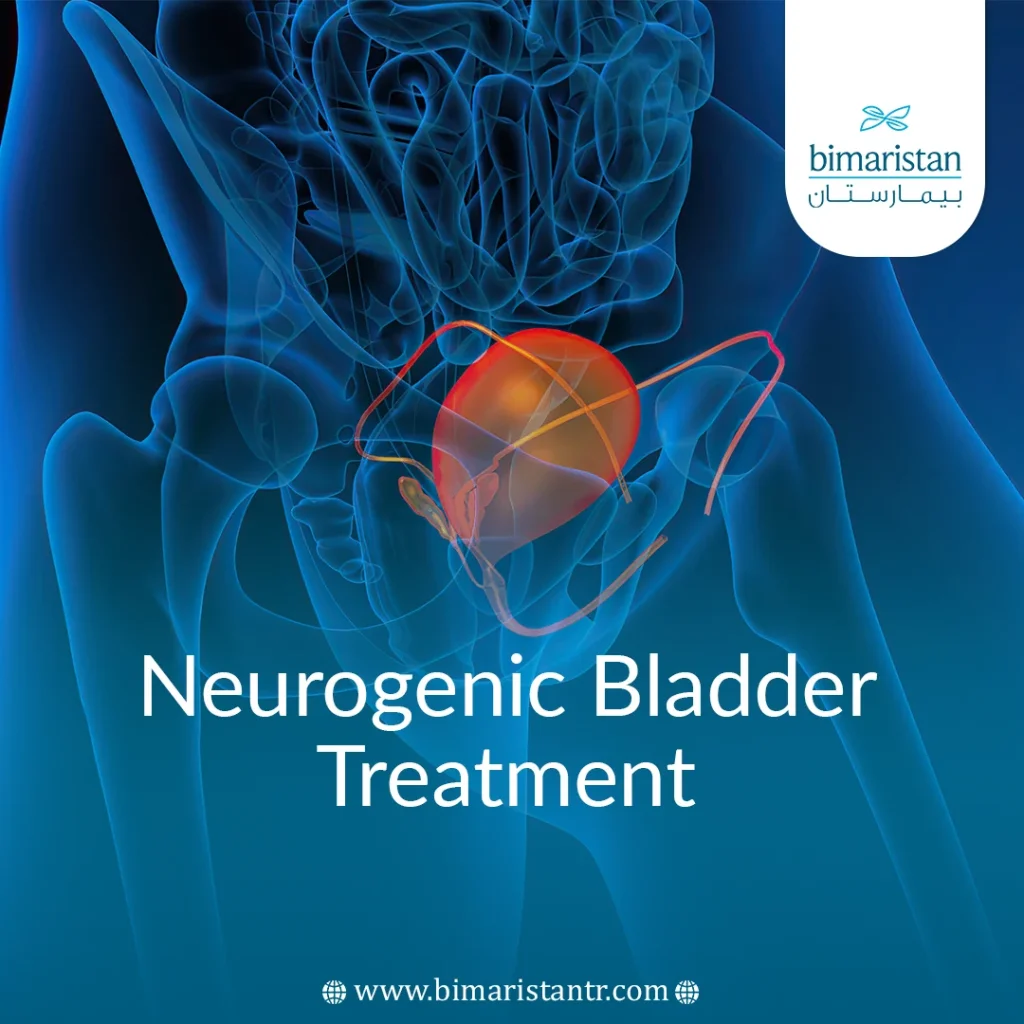Neurogenic bladder treatment is important for those suffering from it due to its annoying symptoms, such as urinary incontinence. Neurogenic bladder disease is treated either with conservative treatment, medication, or surgery.
Introduction to Neurogenic Bladder Treatment in Turkey
Neurogenic bladder is a common disease; its symptoms appear in many patients. It is divided into two main types, which differ slightly in symptoms and treatment, but the mechanism of occurrence of these two types is often the same.
The first type is an overactive bladder, which means that the number of urination exceeds 8 times daily.
The second is the underactive bladder, which is underactive, and it is difficult for the patient to start urinating in this case.
There are many methods to treat these two types, starting with the approved treatment of some exercises and changing lifestyle and diet, through drug therapy and injecting some compounds into the bladder, and ending with surgery.
Bimaristan Medical Center provides support for the treatment of neurogenic bladder and provides advanced health care and qualitative surgeries to treat neurogenic bladder disease in Turkey.
How does neurogenic bladder disease occur?
The normal process of urination in humans occurs through the coordination and agreement of nerve signals coming to the bladder muscles. Hence, urine flows out of it through the urethra (a tube that passes from the bladder to the outside of the body).
The bladder wall consists of muscles that are subject to the orders of the autonomic nervous system (involuntary). The beginning of the urethra below the bladder is surrounded by a ring-shaped muscle called the urethral sphincter, which is also subject to the orders of the same system.
The normal process of urination is interfered with by orders from the brain that carry the character of will, innervating an additional urethral sphincter (other than the previous sphincter), so the person does not urinate in inappropriate places and can control his desire to urinate until he reaches the bathroom.
When the patient reaches the bathroom and begins urinating, the muscles of the bladder wall contract and the urethral sphincters relax. Thus, urine comes out until the bladder empties, at which point its wall relaxes again, and the urethral sphincters contract again.
In the neurogenic bladder, damage occurs to the nerves that control the action of its muscles, so there is no coordination between the muscles, which may not contract at all or may be in a state of permanent contraction.
As a result, one of two types of neurogenic bladder occurs (overactive bladder or hypoactive bladder), and the patient suffers from symptoms that vary according to the type he has been infected with.

Symptoms of neurogenic bladder
There are two main types of neurogenic bladder, so the symptoms vary from one person to another, and although their symptoms differ, they may be present together in the same patient. These symptoms include:
- Urinary tract infection: This is the first symptom. Inflammation and infection of the urinary tract occur due to incomplete urine emptying, which encourages bacteria to grow. Symptoms include burning when urinating and high temperature.
- Urinary incontinence (involuntary urination) and urinary dribbling: Leakage occurs due to the failure of the urethral sphincter to close or due to excessive contraction of the bladder.
- Urinary urgency: This occurs in an overactive bladder, where the bladder contracts even when there is a small amount of urine in it. The patient feels an immediate urgent need that cannot be postponed with the need to go to the bathroom, but only a small amount of urine comes out. If ignored, urinary incontinence may occur.
- Frequency (frequent urination): It also occurs in an overactive bladder where the number of times the person urinates is more than 8 times a day.
- Loss of the feeling of bladder fullness: It occurs in one of the secondary types of neurogenic bladder, which is when the injury is in certain areas of the brain (central brain dysfunction), so the patient urinates unconsciously and suddenly, and is unable to hold the urine to reach the bathroom.
- Difficulty starting to urinate and urinary retention: This occurs in an underactive bladder, where the bladder expands and fills, and the patient is unable to empty it. Even when urination occurs, the patient is unable to empty all of the urine into it, and it remains full (this is one of the predispositions to urinary tract infections).
Complications of neurogenic bladder
If neurogenic bladder is not treated and its symptoms persist for a long time, serious complications may occur that lead to several diseases, some of which may be life-threatening in the long term. These complications of neurogenic bladder include:
- Kidney, bladder, or urethral stones
- Kidney damage and hydronephrosis (which may lead to renal failure) due to urine retention in the kidneys
- Recurrent infections and pyelonephritis may occur
- Skin infections due to urinary dribbling or urinary incontinence and lack of cleaning
Predispositions to neurogenic bladder
Neurogenic bladder is considered a neurological disorder, so the predispositions for its occurrence are, in general, neurological diseases or diseases that have led to injuries to the nerves supplying the bladder, which leads to its symptoms. Neurogenic bladder affects patients with:
- Diabetes: leads to a lack of blood supply to the nerves, which causes them to die and thus the bladder loses its innervation.
- Infection: especially viral infection of the bladder nerves (such as herpes zoster).
- Genetic abnormalities in the nerves (symptoms of neurogenic bladder may be apparent here in children)
- Some congenital neurological diseases, such as spina bifida
- Poisoning with some heavy metals such as arsenic and lead (battery factory workers due to continuous exposure)
- Brain or spinal cord tumors or stroke
- Severe injuries and bruises that cause damage to the brain and spinal cord
- Alzheimer’s, multiple sclerosis and Parkinson’s disease
- Major pelvic surgeries
Neurogenic bladder treatment in Turkey
Neurogenic bladder is treated in Turkey according to the patient’s symptoms. After determining its type, Bimaristan Medical Center will guide you to the best doctors in Turkey, where the latest neurogenic bladder treatment methods will be provided to you. Treatment plans include several methods, and the treatment method varies according to the severity of the patient’s condition.
Neurogenic bladder disease is an incurable disease, so it is a chronic disease, but it is manageable, meaning that we cannot treat it completely and restore the nerves to their former state, but we can control its symptoms in an excellent way and improve the patient’s quality of life.
Neurogenic bladder treatment begins with conservative, non-pharmacological methods. If the patient does not show improvement, we resort to using medications, and finally, we may resort to a surgical solution if the above does not work.
Treatment of Neurogenic Overactive Bladder
Treatment by changing lifestyle
It has five basic points:
- Delaying urinary emptying: i.e. not responding to the urgent desire to urinate and not going to the bathroom immediately. The patient begins by delaying a few minutes first and then gradually increases this period.
- Setting urinary emptying times: i.e., going to the bathroom at specific times during the day and adhering to these times (for example, going to the bathroom every 3 hours).
- Contracting the pelvic floor muscles: This movement is used when feeling the need to go to the bathroom, where the patient here contracts and relaxes the pelvic floor muscle as many times as he can and as quickly as possible.
- This allows nerve signals to be sent to the contracted bladder to relax. This movement is accomplished by closing the anus and urinating voluntarily (as when we hold back defecation or urination when we feel an urgent need to relieve ourselves).
- Bladder diary: This is a method by which the patient records the times he enters the bathroom and the number of times he urinates during the day and whether it is accompanied by a certain food or drink or if the symptoms are worse if he does not drink fluids.
- Changing the patient’s diet: Reducing weight and avoiding carbonated drinks, coffee, tea, alcohol and citrus fruits such as oranges may help in treating neurogenic bladder.
Medication treatment
To treat neurogenic overactive bladder, an antispasmodic medication such as Oxybutynin and Tolterodine is often used, which are cholinergic receptor antagonists that lead to relaxation of the bladder (the best medication for treating neurogenic bladder).
Neurogenic Bladder Treatment by Botox Injections in Turkey
This method is used in neurogenic overactive bladder where Botox (Botox is a muscle-paralyzing botulinum toxin) is injected into the spasmodic bladder to relax it. This method may be useful in treating many patients, but some may relapse and need to be re-injected after 6 months or a year.
Neurogenic Bladder Treatment by Modifying Nerve Signals in Turkey
This method of treatment is done by sending carefully studied, harmless, and painless electrical charges that counteract the work of the nerve signals coming to the bladder (those that urge it to contract).
This method is used to treat neurogenic bladder with overactivity and a battery may be installed under the skin to pass these charges or by injecting needles into one of the nerves in the leg.
Treatment of underactive neurogenic bladder
Treatment through lifestyle changes
It includes four main points:
- Setting urinary emptying times: every 3 hours, for example
- Double emptying: that is, while you urinate and the urine flow ends, wait a few minutes and then try to empty your bladder again.
- Bladder diary: which is setting the times to go to the bathroom and how it is affected by food and drink, gives the doctor an idea of your symptoms and whether they improve or worsen.
- Changing the diet: and avoiding the foods and drinks mentioned above.
Treatment of underactive neurogenic bladder using a catheter
This method is done either by using a temporary catheter, where the patient is taught how to install the catheter in sterile and clean conditions to prevent urinary tract infections (to avoid urinary tract infections).
Or a permanent catheter may be installed for the patient with a neurogenic bladder to empty his urine if he cannot install it himself.

Surgical treatment of neurogenic bladder in Turkey
If the symptoms of neurogenic bladder do not improve with the previous treatments, the alternative is to resort to surgical treatment in order to improve the patient’s life. Surgical operations in the treatment of neurogenic bladder include several types of procedures as follows:
Urethral sphincter biopsy
The treatment here is done by the surgeon removing part of the muscle surrounding the urethra and restoring the area to enable the patient to hold urine better. The biopsy may be partial or complete.
Installing an artificial urethral sphincter
The treatment is done by installing an artificial sphincter equipped with a battery that is implanted under the skin to open the sphincter during urination and close it at other times.

Bladder fabrication
The treatment here is done by cutting a part of the patient’s intestine and making it into a bag connected to the bladder so that it can hold a larger amount of urine and reduce the pressure of filling it.
Urinary diversion in Turkey
The treatment here is done by installing an external bag for the patient so that urine can exit into it. This cancels the role of the urination process in the patient and relieves him from the problems and symptoms of the neurogenic bladder.
Contact us if you want to get rid of the symptoms of the neurogenic bladder and live a life closer to normal; the doctors of the Bimaristan Medical Center provide the latest techniques for treating the neurogenic bladder in Turkey.
Sources:
- UNIVERSITY OF MICHIGAN HEALTH
- Urology Care Foundation
- Johns Hopkins
